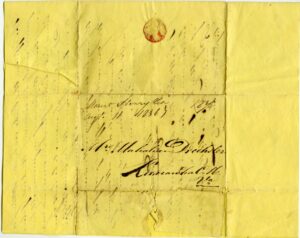My momma always said life was like a box of chocolates.
You never know what you’re gonna get.
Forrest Gump

Kelley House received a remarkably interesting “box of chocolates” last month – a well-packed bin of papers that had belonged to members of the Kelley family, a gift from John Maulbetsch.
Lifting the lid, we unwrapped cardboard sleeves to reveal photographs of people we had never seen before. There were also numerous bundles of envelopes containing correspondence detailing the real estate transactions of the Kelley family when they finally withdrew from their more than 120-year presence in Mendocino. And then, there was this odd folded letter, written on soft and worn canary yellow paper in a steeply slanted, quill-penned hand.
It was almost illegible, what with the words from the reverse side bleeding through the thin paper. It began “My dear Mahalia,” and at the top was the date – Aug. 10th, 1836. That is pretty old. And who is Mahalia?
Examining the page for some clues, a few words could be made out: “to return to your arms” and “thoughts and dreams about you.” This looks like a 184-year-old love letter! It was signed, “Your affectionate husband, C. W. Drechsler.” Could this be a relative of Elise Kelley’s millionaire husband, Louis Philippe Drexler/Drechsler?
Here was a mystery that must be solved, so we asked you, our readers, to help us transcribe the letter. Our plea was quickly answered by Rachel Barahal, who is in Ukiah caring for her aged parents. She emailed us that she had some time and would love to help.
We sent her several images of the document, varying the brightness, contrast, and color of the image to tone-down the “noise” of the reverse-page words. While this helped with legibility, there was still that extravagantly cursive handwriting to cipher out.
After seeing the images, Rachel wrote, “I can see why this is a project! I was going to get started on this tomorrow, but after doing a quick scan of the first and last page and doing some research on Charles W. Drechsler and Mahalia Drechsler, what I found was so interesting, I couldn’t stop.”
As she worked, the letter opened a window into another world, when travel was most efficiently done by water, as there were few good roads. Charles said he was writing while “night-watching for a steamboat from Nashville” that would take him back home along the watery highways of the Ohio, Cumberland, and Kanawha Rivers in Tennessee, Kentucky and West Virginia.
Rachel discovered with additional research that Mr. Drechsler traveled a lot and appeared to have been in the salt business. The Kanawha Valley region in West Virginia, where he resided with his family, was the largest producer in the country, pre-civil war. Who knew?
While working on the project Rachel said, “I became really fascinated with Charles’ thoughts, and like a puzzle, each word I deciphered gave me more insight into the person. He was not ordinary.”
Indeed, Charles’ writing is extraordinary: “Disappointments give birth to philosophy which teach us to bear the evils of life with resignation – Like the Globe upon which we revolve, our fleeting course is but a day, and if one part of the day is visited by light, the other is thrown into darkness – however I suffer myself to be led calmly down the stream of time to the ocean of futurity which has boundaries; while in the contemplation of the present harmony of nature, I raise my soul towards its supreme Author and hope for a more happy destiny in another state of existence. Enough.”
The letter’s tone alternates between such gloomy thoughts and those of fervent hope. “I have much to tell you when I see you. I hope you are in good health and have become wise from experience not to mind. The affection that links us together, although separated, is holy and enduring – think not of absence of love in the absence of my person. My love burns with a brilliant flame and never will cease.” You can see why this letter was saved. Words like these transcend the passage of years.
With the letter transcribed, our mystery is solved, and we now know something about the unusually thoughtful man who fathered Elise Kelley’s husband. Yet, I am still in awe about how this letter came to us, and how many times somebody tucked it into a special place for safekeeping, handing it down over and over again for yet another generation. A truly special chocolate for us to enjoy in this present time!
Kelley House wishes to thank Rachel Barahal for her assistance with this intriguing puzzle. She has helped us add one more piece to the interconnected history of the coast and its people. If you would like to contribute your time to the Museum’s archival and research projects, contact us at [email protected].